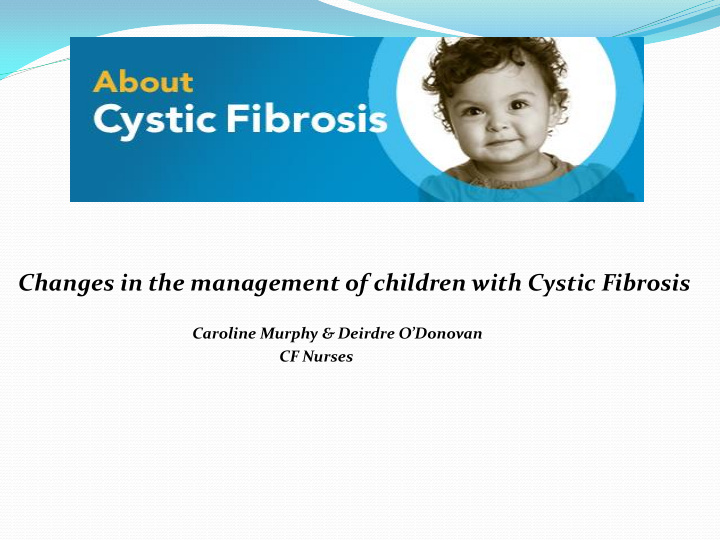



Changes in the management of children with Cystic Fibrosis Caroline Murphy & Deirdre O’Donovan CF Nurses
What Is Cystic Fibrosis? Cystic fibrosis (CF) is an inherited chronic disease that primarily affects the lungs and digestive system of about 1200 children and adults in Ireland (70,000 worldwide). In Cork, the Paediatric population is 100, the Adult population is 170. A defective gene and its protein product cause the body to produce unusually thick, sticky secretions which causes The fluid lining in the airways to be reduced, resulting in excess sticky secretions that are prone to infection and difficult to expectorate In the pancreas, the sticky secretions block the flow of digestive juices into the gut leading to impaired digestion and poor absorption of food
Symptoms of Cystic Fibrosis • very salty-tasting skin • productive cough • frequent chest infections • wheezing or shortness of breath • poor growth/weight gain in spite of a good appetite • frequent greasy, bulky stools or difficulty in passing stools
Diagnosis Newborn screening Sweat test Genotyping Faecal elastase
Genetics
Newborn Screening Aim of NBS is early diagnosis before presentation with respiratory symptoms and malabsorption. Introduced in July 2011 Heel Prick test 6 designated CF centres First phone call contact by CF Nurse to parents
Newborn Screening - Cork data July 16-17 July 15- 16 July 14-15 July 13-14 July 12 - 13 July 11- 12 0 2 4 6 8 10 12 14 16 18 diagnosis Calls
Statistics About 50 new cases of Cystic Fibrosis in Ireland are diagnosed each year. Because of new born screening, most babies with CF should now be diagnosed quickly Around 55% of the CF patient population in Ireland is aged 18 or older. Today, advances in research and medical treatments have further enhanced and extended life for children and adults with CF. Many people with the disease in Ireland can now expect to live into their 30s, 40s and beyond.
What are the changes in management of children with Cystic Fibrosis?
Nutrition Aim to maintain an appropriate weight above the 50 TH centile Appropriate weight tends to correlates with good pulmonary function 95% of CF patients are pancreatic insufficient Creon is the pancreatic enzyme given to aid absorption of fats. Stools should be monitored by parents, if stools are oily this means creon needs to be adjusted by the dietician Fat soluble vitamins A,D,E,K are supplemented. Levels are checked annually Calcium supplements maybe required to prevent osteoporosis- bone density scan every 5yrs. High fat diet maybe required depending on BMI. Nutritional supplements e.g Calogen, Fortisip, Shakes Enteral feeds (PEG) if low BMI and FTT
Nutrition Appetite stimulants H2 antagonists and proton pump inhibitors CF patients are at risk of Distal Intestinal Obstruction Syndrome (DIOS) and constipation. CF Patients may develop Cystic Fibrosis Related Diabetes (CFRD) Increased salt intake in hot weather and avoid dehydration
Physiotherapy Past Present - child was placed prone for - PEP, Acapella & precussion Autogenic drainage - Increased emphasis on physical exercise
Pulmonary management PO/IV antibiotics Excessive mucus Nebulised mucolytics secretion Nebulised antibiotics Lung damage obstruction +/- steroids +/- antifungals Genetic modifiers Mucus Inflammation stagnation infection
Infection Control l Preventing bacterial Microbiology is fundamental to acquisition & minimising CF management cross infection Most commonly cultured organisms: Staph aureus Single en-suite room Haemophilus influenzae No sharing of toilets as inpatient or Pseudomonas Aeruginosa – chronic at clinic conolisation Avoid interaction with other CF Aspergillus patients Non tubercular mycobacteria Bring own medical devices Antimicrobials are decided by what is Hospital Segregation policies cultured on throat swab or sputum High standard of hand hygiene if a child is symptomatic must be practiced by healthcare professionals
Recommend
More recommend